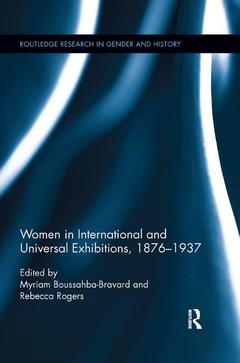Description
Women in International and Universal Exhibitions, 1876–1937
Routledge Research in Gender and History Series
Coordinators: Rogers Rebecca, Boussahba-Bravard Myriam
Language: English
Subject for Women in International and Universal Exhibitions...:
Keywords
Conseil National Des Femmes; Esplanade Des Invalides; womans; Woman’s Political Future; building; World’s Columbian Exposition; Women’s Pavilion; columbian; Femme Nouvelle; exposition; Woman’s Building; Paris Universal Exposition; womens; Chicago World’s Columbian Exposition; pavilion; Mormon Women; Myriam Boussahba-Bravard; Paris Universal Exhibition; Julie Verlaine; National Woman’s Suffrage Association; Ursula Tania Estrada; Universal Exposition; Linda Kim; Universal Exhibitions; Gwen Jordan; La Parisienne; Teresa Pinto; Transnational Feminism; Anne R; Epstein; Chicago Columbian Exposition; Claudine Raynaud; De Morsier; Christiane Demeulenaere-Douyère; Pan-Pacific Women’s Association; James Keating; Des Femmes; Karen Offen; Women Lawyers; Tracey Jean Boisseau; Henri Sellier; Siân Reynolds; United States’s National Council; National Library; Belly Dance
Publication date: 12-2019
· 15.2x22.9 cm · Paperback
Publication date: 08-2017
· 15.2x22.9 cm · Hardback
Description
/li>Contents
/li>Readership
/li>Biography
/li>
This book argues for the importance of bringing women and gender more directly into the dynamic field of exposition studies. Reclaiming women for the history of world fairs (1876-1937),it also seeks to introduce new voices into these studies, dialoguing across disciplinary and national historiographies.
From the outset, women participated not only as spectators, but also as artists, writers, educators, artisans and workers, without figuring among the organizers of international exhibitions until the 20th century. Their presence became more pointedly acknowledged as feminist movements developed within the Western World and specific spaces dedicated to women?s achievements emerged.
International exhibitions emerged as showcases of "modernity" and "progress," but also as windows onto the foreign, the different, the unexpected and the spectacular. As public rituals of celebration, they transposed national ceremonies and protests onto an international stage. For spectators, exhibitions brought the world home; for organizers, the entire world was a fair.
Women were actors and writers of the fair narrative, although acknowledgment of their contribution was uneven and often ephemeral. Uncovering such silence highlights how gendered the triumphant history of modernity was, and reveals the ways women as a category engaged with modern life within that quintessential modern space?the world fair.
Introduction: Positioning Women in the World Fairs, 1876-1937 Myriam Boussahba-Bravard and Rebecca Rogers Part I: Exhibiting Women: Collectors, Artists and Students 1. Expositions and Collections: Women Art Collectors and Patrons in the Age of the Great Expositions Julie Verlaine 2. Unpretentious Paintings: Mexico’s National School of Fine Arts’ Women Students at the 1893 Chicago Columbian Exposition Ursula Tania Estrada 3. Inserting the Personal in the International: The American Girl at the 1900 Paris Exposition Linda Kim Part II: Promoting Women: Professionals, Workers and Organizers 4. “After Mature Deliberation”: Women Lawyers’ Infiltration of the 1893 World Columbian Exposition Gwen Jordan 5. International Expositions and the Rewriting of Portuguese Women’s History (1889-1908) Teresa Pinto 6. A “Reason to Act, an Ideal to Strive Towards”: Women as Intellectual Organizers at the Paris Exhibition of 1900 Anne R. EpsteinPart III: Staging Otherness: Women on and from the Margins 7. African American Women’s Voices at the 1893 Chicago World Fair Claudine Raynaud 8. Between Knowledge and Spectacle: Exotic Women at International Exhibitions (Paris, 1889 and 1900) Christiane Demeulenaere-Douyère 9. International Activism After the Fair: New South Wales, Utah, and the 1893 World’s Columbian Exhibition James Keating Part IV: Mobilizing Women: National, International, and Transnational Feminism(s) 10. Rendezvous at the Expo: Building a Franco-American Women’s Network, 1889-1893-1900 Karen Offen 11. Forging the Transnational out of the International: Feminist Internationalism at World’s Fairs and International Exhibitions Tracey Jean Boisseau
Myriam Boussahba-Bravard is Professor of Nineteenth-Century British History in the English and American Studies faculty of Université Paris Diderot.
Rebecca Rogers is Professor in the Histoire of Education at the Université Paris Descartes.




